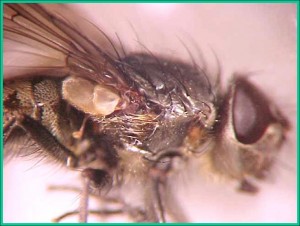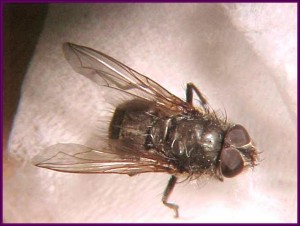
Cluster Fly
Cluster Fly (Pollenia rudis)
The cluster fly is one of several species of insects that enter homes in late summer and early fall in search of protected sites in which to spend the winter. Cluster flies resemble the common house fly but differ in that they have a patch of yellow hairs under their wings. They enter homes and other structures by squeezing through cracks around windows and doors, loosely hung siding, soffit vents, louvers and other similar entry points. In heated structures, cluster flies may remain active during the winter months and may continually emerge from their hiding spots and find their way into living areas throughout the winter. Their presence is usually not appreciated by other residents of the home. Besides being a tremendous annoyance, cluster flies are harmless; they do not feed or lay eggs during the winter months. They do not harm woolens, fur or feathers, nor do they infest foods in kitchen cupboards. They do not bite and they are not known to transmit diseases.
The cluster fly maggot is an internal parasite of earthworms and the flies are among the first to be active in the spring. They can be observed buzzing around yards just above the ground. They lay their eggs in cracks in the soil and the eggs hatch in about three days. Newly hatched maggots grab onto earthworms as they slither by and burrow into the worm to feed. Four to five weeks are required to complete a life cycle. The worm does not usually survive the experience. There are up to four generations of cluster flies in Michigan each year.
There is no easy remedy for cluster fly problems. It is practically impossible to kill enough of them to make a difference once they have found their way into wall voids, ceilings voids and attics. Once they’re in, they’re in and there is not much we can do about it. When temperatures warm in the spring, the flies attempt to find their way back outside to lay eggs. Many of these find their way into the living areas of the house rather than outside. Aggressive and costly insecticide applications will only temporarily reduce the number of flies inside the home because it is nearly impossible to treat every hidden area that may be harboring insects. The exposed flies that are killed by such treatments are quickly replaced by others emerging from the ‘woodwork’.
Sealing exterior cracks and holes on the outside of the house with caulk, especially south and west facing walls, can help to reduce the number of flies that find their way inside. Sealing cracks around electrical outlet boxes, switches and light fixtures, and around window and baseboard molding on the inside walls will help keep the flies trapped within the walls. In older homes with double-hung windows equipped with pulleys, flies commonly enter living areas through the pulley opening. Masking tape applied over the opening will keep flies from entering through this route. Indoor aerosol insecticides are effective in killing exposed flies during the winter and spring months. A vacuum cleaner is a pretty effective method of removing the sluggish, slow moving flies from the house as well.
Treating yards with insecticides to kill earthworms has not been shown to be effective in reducing the number of flies entering homes. Spraying the outside walls of homes with a persistent insecticide, especially the south and west facing walls, in August can also help reduce the number of flies entering homes. Persistent insecticides include permethrin (sold under a variety of brand names), cyfluthrin (sold as Bayer Advanced Garden Insect Control for homeowners or Tempo for commercial applicators) or one of the Ortho products. The spray should be applied by August 15 when the flies are beginning to congregate on outside walls.
Another option is hiring a professional pest control operator to treat the inside and outside of the house. These services can be expensive. And don’t expect miracles. Chances are you will continue to see flies even after ‘professional’ treatments.





 Print
Print Email
Email




